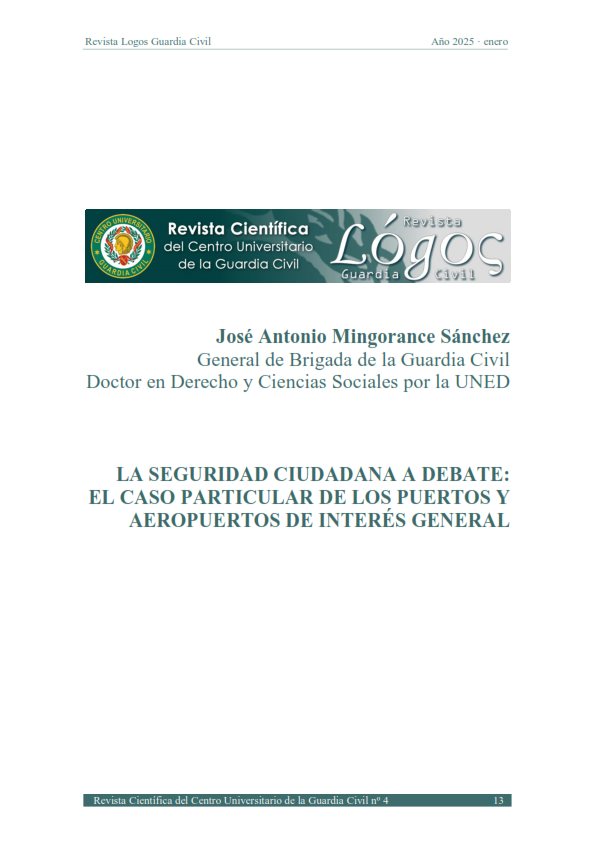Citizen security under debate: the particular case of ports and airports of general interest
Keywords:
Public security, citizen security, legal right, police custody of ports and airportsAbstract
This work aims to reach conclusions on the concept and content of the legal right citizen security and its projection on ports and airports of general interest. Starting from the analysis made by the various doctrinal positions on the legal right and continuing with the jurisprudential interpretations on the material content of public security and citizen security, we will immerse ourselves in the security model of the autonomous State. To this end, we will start from a qualitative approach, making use of a descriptive and deductive methodology to present a social reality such as the necessary conditions of security in the free development of the individual in society, as well as its introduction and evolution in our legal system. To conclude with an inductive methodology where the foundations of the necessary protection of citizen security are laid, it can be stated that this is also projected in a special way on the custody of specific spaces such as ports and airports. These facilities are the exclusive custody of the Civil Guard in the field of public security, but which require recourse to the general powers of the security police to also carry out public security functions in a specific or singular aspect such as the protection of these ports and airports.
Downloads
References
Bianchi Pérez, P.P. (2009). Evolución del concepto de buen jurídico en la dogmática penal. Revista Dikaiosyne, (22), 29-53.
Carnevali Rodríguez, R. (2000). Algunas reflexiones en relación a la protección penal de los bienes jurídicos supraindividuales. Revista Chilena de Derecho, (27), 135-153.
Fernández Fernández, A. (2015). Orden Público y seguridad ciudadana. Modificaciones normativas. Revista de Derecho UNED, (17), 287-318.
García Arroyo, C. (2022). Sobre el concepto de bien jurídico. Especial consideración de los bienes jurídicos supraindividuales-institucionales. Revista electrónica de ciencia penal y criminología, 24.
Hassemer W. y Muñoz Conde, F. (1989). Introducción a la Criminología y al Derecho Penal. Editorial Tirant Lo Blanch.
Hormazábal Malarée, H. (1991). Bien jurídico y Estado social y democrático de derecho, el objeto protegido por la norma penal. Editorial Promociones y Publicaciones Universitarias SE.
Kierszenbaum, M. (2009). El bien jurídico en el Derecho penal. Algunas nociones básicas desde la óptica de la discusión actual. Lecciones y Ensayos, (86), 187-211.
Kindhäuser, U. (2009). Estructura y legitimación de los delitos de peligro del Derecho penal. InDret.
Muñoz Conde, F. (2001). Introducción al Derecho penal. 2ª Edición. B de f.
Piugserver Martínez, J.A. (2015). La Ley Orgánica 4/2015, de 30 de marzo, de Protección de la Seguridad Ciudadana. Seguridad y Ciudadanía: Revista del Ministerio del Interior, (14), 49-68.
Restrepo Rodríguez, D. (2010). Aproximación al Concepto de Bien Jurídico en un “Derecho Penal Colonizado”: El Caso Colombiano. Nuevo Foro Penal, (75), 131-193.
Silva Sánchez, J. M. (1992). Aproximación al derecho penal contemporáneo. JM Bosch.
Villegas Paiva, E.A. (2010). Los bienes jurídicos colectivos en el derecho penal. Consideraciones sobre el fundamento y validez de la protección penal de los intereses macrosociales. Obtenido de Université de Fribourg: https://www. unifr. ch/ddp1/derechopenal/articulos/a_20091207_03. pdf.

Downloads
Published
How to Cite
Issue
Section
License
Copyright (c) 2025 José Antonio Mingorance Sánchez

This work is licensed under a Creative Commons Attribution-NonCommercial-NoDerivatives 4.0 International License.
-
Attribution — You must give appropriate credit, provide a link to the license, and indicate if changes were made. You may do so in any reasonable manner, but not in any way that suggests the licensor endorses you or your use.
-
NonCommercial — You may not use the material for commercial purposes.
-
NoDerivatives — If you remix, transform, or build upon the material, you may not distribute the modified material.
- No additional restrictions — You may not apply legal terms or technological measures that legally restrict others from doing anything the license permits.



